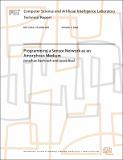Programming a Sensor Network as an Amorphous Medium
Author(s)
Bachrach, Jonathan; Beal, Jacob
DownloadMIT-CSAIL-TR-2006-069.pdf (365.6Kb)
Additional downloads
Other Contributors
AIRE
Advisor
Howard Shrobe
Metadata
Show full item recordAbstract
In many sensor network applications, the network is deployedto approximate a physical space. The network itself is not ofinterest: rather, we are interested in measuring the propertiesof the space it fills, and of establishing control over thebehavior of that space.The spatial nature of sensor network applications meansthat many can be expressed naturally and succinctly in termsof the global behavior of an amorphous medium---a continuouscomputational material filling the space of interest. Althoughwe cannot construct such a material, we can approximateit using a sensor network.Using this amorphous medium abstraction separates sensornetwork problems into two largely independent domains.Above the abstraction barrier we are concerned with longrangecoordination and concise description of applications,while below the barrier we are concerned with fast, efficient,and robust communication between neighboring devices.We apply the amorphous medium abstraction with Proto,a high-level language for programming sensor/actuator networks.Existing applications, such as target tracking andthreat avoidance, can be expressed in only a few lines of Protocode. The applications are then compiled for execution on akernel that approximates an amorphous medium. Programswritten using our Proto implementation have been verified insimulation on over ten thousand nodes, as well as on a networkof Berkeley Motes.
Date issued
2006-06Citation
DCOSS 2006 (Extended Abstract)
Other identifiers
MIT-CSAIL-TR-2006-069
Series/Report no.
Massachusetts Institute of Technology Computer Science and Artificial Intelligence Laboratory
Keywords
amorphous computing